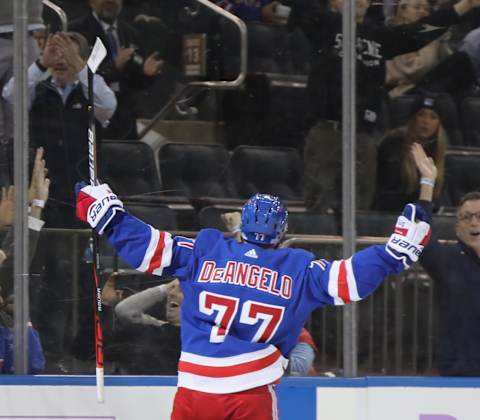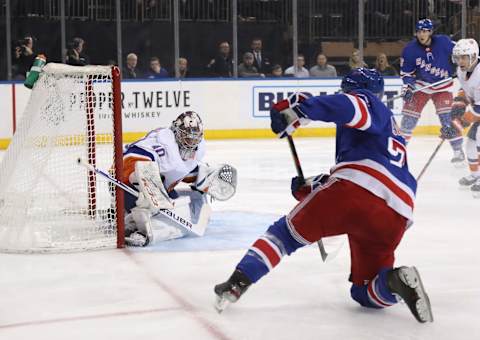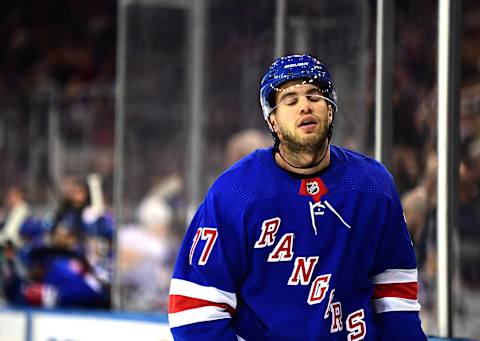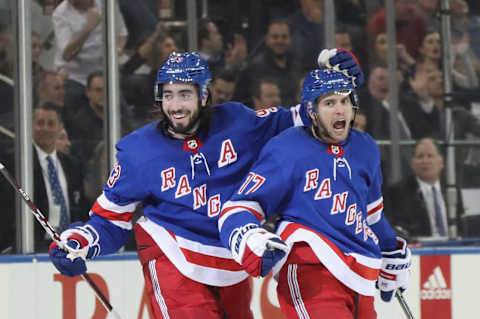Can the New York Rangers keep Tony DeAngelo?


The New York Rangers and Tony DeAngelo are at a crossroads
New York Rangers defenseman Tony DeAngelo is coming off a career year and is an arbitration eligible restricted free agent (RFA). The Rangers, like many teams in the NHL are in salary cap bind. The Rangers added cap space with the recent trade of Marc Staal and the buyout of Henrik Lundqvist. The Rangers now have just under $23.1 million in cap space with only 12 position players and one goalie under contract at the NHL level.
Hard decisions are in the New York Rangers immediate future. The biggest and hardest among them is what to do with Tony DeAngelo. They could retain him, but at what cost and term? They could trade him, but for what return? The thought of a trade adds in the questions of production and situational replacement. Unless DeAngelo is willing to take a short term, team friendly deal, no decision is simple.
Last season, the Rangers had all of the leverage in contract negotiations with DeAngelo. It was a take it or leave it offer, where ‘leave it’ would have meant losing a year of his career. With no arbitration rights and the team not budging, DeAngelo, after a short holdout, finally signed for $925,000 on a one year deal. This year however, with arbitration rights, and a top four finish in points by a defenseman, DeAngelo now has all the leverage.
The Rangers current salary cap situation is well known, and a defenseman as offensively gifted as DeAngelo could quickly break the bank. The negotiations will boil down to how much DeAngelo wants to remain a Ranger. There is only so much cap space to go around and the Rangers need to bring in seven other position players into the fold just to ice a full NHL team.
The Rangers also need to do all they can to avoid arbitration. In no way, shape or form should the team allow an outside influence to be the deciding factor of this situation. To review the best course of action, let’s look at the Good, the Bad and the Ugly of Tony DeAngelo, to make a detailed assessment.

DeAngelo knows how to put the biscuit into the basket
Tony DeAngelo just had the most prolific offensive season of any New York Rangers defenseman since Hall of Famer Brian Leetch. DeAngelo posted a 15 goal, 38 assist and 53 point season with 64.2% of his production at even strength. Ranking him fourth among all NHL defenseman in goals and in points (both overall and at even strength). The defenseman’s season represented a major increase in his offensive output from years past, recording 23 points over his previous career high. Not only was the 2019-20 season the best of his career, he also more than doubled his previous career totals in both goals and points.
Additionally, DeAngelo was utilized as the team’s power play (PP) quarterback. In that role, he received more than three minutes of PP time on ice (TOI) on the average per game. He led all Rangers defenseman in shots on goal (SOG), assists (16), points (19) and TOI while with the man advantage. With DeAngelo at the point on the power play, the Rangers scored 52 PP goals for a conversion rate of 22.91%, seventh best in the NHL and the best of any New York Rangers team of the Cap Era. Individually, he ranked ninth among all NHL defenseman with 19 power play points.
DeAngelo accomplished this as part of the team’s third defensive pair, behind Jacob Trouba and Adam Fox on the right side defenseman depth chart. He was partnered with veteran Marc Staal for most of the season. The pairing mixed and matched the stay at home and offensive defenseman styles, working well against favorable matchups. So did the 55.6% offensive zone start percentage he received. It’s safe to say that Coach Quinn deployed DeAngelo in a manner for him to best succeed offensively.

There are two sides to every puck
Though a major power play contributor and offense driver from the back end, DeAngelo was a defenseman who did not kill penalties. DeAngelo played a team low 6:34 on the penalty kill (PK) in 68 games played. The next lowest times were that of Adam Fox, also known as an offensive defenseman, with just shy of 13 minutes in 70 games and Libor Hajek with 26:30 in 28 appearances. With the added note that Ryan Lindgren played 131:36 while a man down, it highlights that DeAngelo was trusted less than three rookies with the defensive requirements of the PK.
DeAngelo is poised to make more money than proper salary cap management should allow to be dedicated for a third pair defender. It has been suggested recently by Larry Brooks and @blueseatblogs that DeAngelo be moved to the left side. This would be a mistake. A defender who is not trusted to play on the PK should not be expected to handle a move to their weak side.
Further, who would he be paired with? Moving him to the left and pairing with say, Nils Lundkvist when he is ready, would defeat the purpose of moving DeAngelo off the third pairing. Breaking up the Fox-Lindgren second pairing makes little sense, if any. That leaves only one option, and pairing him with Jacob Trouba is a mistake.
Trouba needs a partner who can handle the toughest defensive assignments and that will allow him to unlock his own offensive output. Paired with DeAngelo, Trouba would have to play the stay at home defenseman role to cover for DeAngelo’s offense, at the cost of his own. An assignment such as this would hinder both defenseman.
Likewise a move to wing, which has been a long time discussion here at Blue Line Station would be problematic. Slotting him at right wing would place him behind Pavel Buchnevich and possibly ahead of Kaapo Kakko. Which, in and of itself is an issue since Kakko needs more ice-time in a more predominantly offensive role. DeAngelo on the right wing also leaves no room for Vitali Kavtsov in the top nine. Even more importantly, playing on wing removes the defenseman’s vision from the back end.
DeAngelo’s offensive production, when not leading a rush, is based on him seeing the ice from the backend. Either by joining a play as the trailer, or finding a hole for seam pass, it’s his vision of the whole ice laid out in front of him, and his ability to react to it, that drives his production. It’s the same reason why players like Erik Karlsson, Keith Yandle and Brent Burns remain on the blue line, even if their defensive capabilities are sometimes called into question.

Where do the New York Rangers go from here?
The plain and simple fact is that Tony DeAngelo is a player of luxury. He play’s defense adequately enough to remain in the line-up on the third pair and his offense makes him nearly indispensable. The problem with this dichotomy is that the NHL operates under a salary cap and the New York Rangers are not in a position to afford the contract the defender deserves.
If player and team are unable to agree upon a short term deal, preferably a one year deal, then DeAngelo should be dealt. It will be nearly impossible to replace the production that DeAngelo provides as a third pair defender. So, the Rangers should not even try. Instead the Rangers need to focus on improving their center, left side defense and bottom 6 forward depth. Jeff Gorton should be looking for a hockey trade, using DeAngelo to improve the team immediately.
Even without DeAngelo, the New York Rangers defense is no offensive slouch. In his rookie season Adam Fox’s offense was nearly as potent as DeAngelo’s. Fox scored only five points fewer (all goals) at even strength and recorded more points per 60 minutes on the PP than DeAngelo (5.69 v 5.56). Jacob Trouba is only one season removed from a 50 point season where he quarterbacked the Winnipeg Jets power play. Given a steady partner and more PP time, there’s no reason to believe he won’t improve on his 27 point season.
The unfortunate reality is that it is possible to have too much of a good thing.